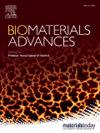Biodegradable copper-containing mesoporous microspheres loaded with ginsenoside Rb1 for infarcted heart repair
IF 5.5
2区 医学
Q2 MATERIALS SCIENCE, BIOMATERIALS
Materials Science & Engineering C-Materials for Biological Applications
Pub Date : 2025-01-02
DOI:10.1016/j.bioadv.2024.214172
引用次数: 0
Abstract
The current unavailability of efficient myocardial repair therapies constitutes a significant bottleneck in the clinical management of myocardial infarction (MI). Ginsenoside Rb1 (GRb1) has emerged as a compound with potential benefits in safeguarding myocardial cells and facilitating the regeneration of myocardial tissue. However, its efficacy in treating MI-related ischemic conditions is hampered by its low bioavailability and inadequate angiogenic properties. In this study, the therapeutic potential of GRb1 is enhanced by a mesoporous basic copper carbonate (BCC) microsphere due to its excellent drug delivery capability and steady angiogenic degradation products (copper ions, Cu2+). The cell experiments revealed that GRb1 and Cu2+ could generate synergistic impacts on anti-cardiomyocyte apoptosis and endothelial cell angiogenesis, while a mouse model of MI illustrated that GRb1 loaded BCC (BCC@GRb1) could significantly enhance cardiac function, diminish the area of infarction and myocardial hypertrophy, reduce cardiomyocyte apoptosis, and augment vascularization within myocardial tissue. This investigation is pioneering in demonstrating the beneficial outcomes of combining drugs with bioactive carriers in myocardial regeneration and introduces a novel, precisely engineered drug delivery system as a potential therapeutic strategy for ischemic heart disease.

可生物降解的含铜介孔微球装载人参皂苷Rb1用于心肌梗死修复。
目前缺乏有效的心肌修复疗法是心肌梗死(MI)临床治疗的一个重要瓶颈。人参皂苷Rb1 (GRb1)是一种具有保护心肌细胞和促进心肌组织再生的潜在益处的化合物。然而,其治疗心肌梗死相关的缺血性疾病的有效性受到其低生物利用度和不充分的血管生成特性的阻碍。在本研究中,由于介孔碱式碳酸铜(BCC)微球具有优异的药物递送能力和稳定的血管生成降解产物(铜离子,Cu2+),因此增强了GRb1的治疗潜力。细胞实验显示,GRb1和Cu2+对抗心肌细胞凋亡和内皮细胞血管生成具有协同作用,而小鼠心肌梗死模型显示,GRb1负载BCC (BCC@GRb1)可显著增强心功能,缩小梗死面积和心肌肥厚,减少心肌细胞凋亡,增强心肌组织内血管化。这项研究开创性地证明了将药物与生物活性载体结合在心肌再生中的有益结果,并引入了一种新的、精确设计的药物输送系统,作为缺血性心脏病的潜在治疗策略。
本文章由计算机程序翻译,如有差异,请以英文原文为准。
求助全文
约1分钟内获得全文
求助全文
来源期刊
CiteScore
17.80
自引率
0.00%
发文量
501
审稿时长
27 days
期刊介绍:
Biomaterials Advances, previously known as Materials Science and Engineering: C-Materials for Biological Applications (P-ISSN: 0928-4931, E-ISSN: 1873-0191). Includes topics at the interface of the biomedical sciences and materials engineering. These topics include:
• Bioinspired and biomimetic materials for medical applications
• Materials of biological origin for medical applications
• Materials for "active" medical applications
• Self-assembling and self-healing materials for medical applications
• "Smart" (i.e., stimulus-response) materials for medical applications
• Ceramic, metallic, polymeric, and composite materials for medical applications
• Materials for in vivo sensing
• Materials for in vivo imaging
• Materials for delivery of pharmacologic agents and vaccines
• Novel approaches for characterizing and modeling materials for medical applications
Manuscripts on biological topics without a materials science component, or manuscripts on materials science without biological applications, will not be considered for publication in Materials Science and Engineering C. New submissions are first assessed for language, scope and originality (plagiarism check) and can be desk rejected before review if they need English language improvements, are out of scope or present excessive duplication with published sources.
Biomaterials Advances sits within Elsevier''s biomaterials science portfolio alongside Biomaterials, Materials Today Bio and Biomaterials and Biosystems. As part of the broader Materials Today family, Biomaterials Advances offers authors rigorous peer review, rapid decisions, and high visibility. We look forward to receiving your submissions!
文献相关原料
公司名称
产品信息
阿拉丁
Sodium carbonate (Na2CO3)
阿拉丁
Sodium carbonate (Na2CO3)
阿拉丁
Sodium carbonate
阿拉丁
Sodium carbonate

 求助内容:
求助内容: 应助结果提醒方式:
应助结果提醒方式:


